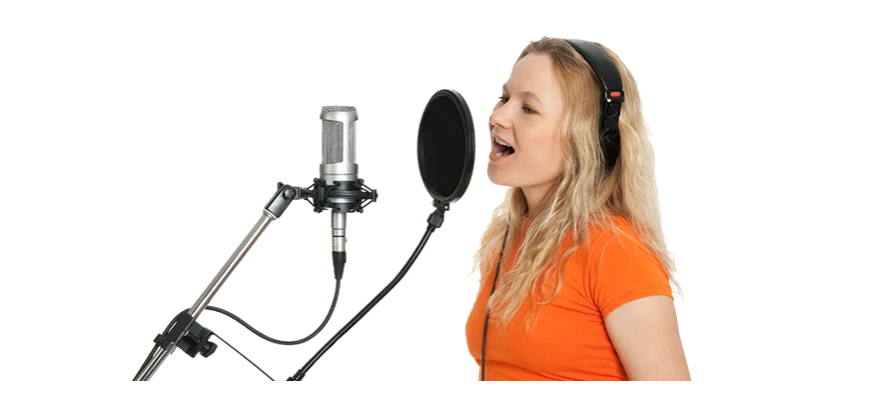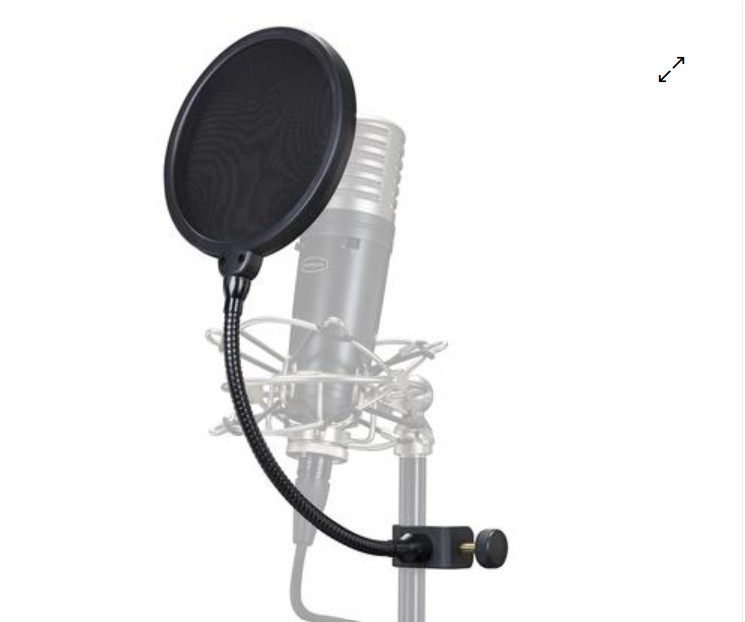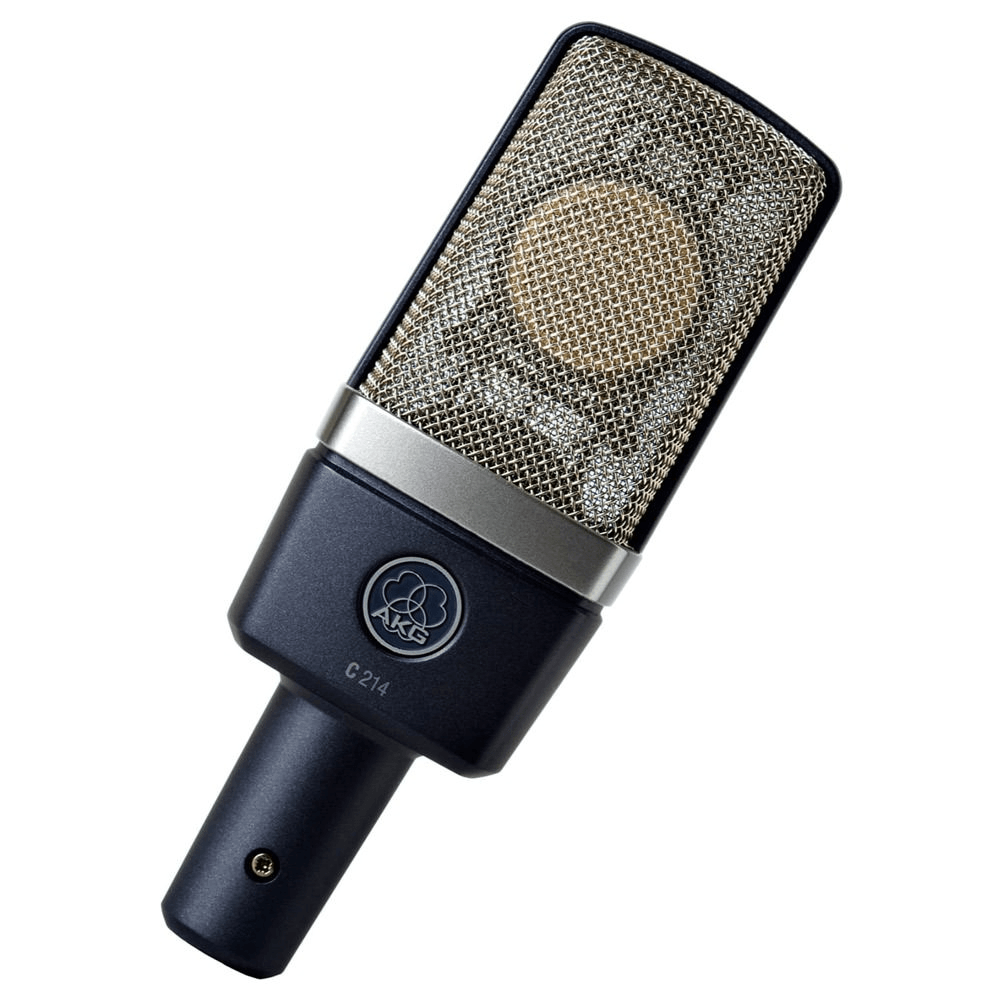Are you an aspiring vocalist searching for studio-quality sound without breaking the bank? Look no further! The right microphone is crucial for capturing the clarity and richness of your voice, and thankfully, you don’t have to spend a fortune to find a great one. In this listicle, we’ve rounded up the best budget-friendly condenser microphones that deliver professional-grade audio. Perfect for home studios, podcasters, and musicians, these picks promise to elevate your vocal recordings without stretching your wallet. Get ready to make your vocals shine with our top affordable condenser microphone selections!
When scouring the market for the best cheap condenser microphone for vocals, it’s important to judge them based on several key criteria to ensure you’re getting the best quality for your budget. Here’s a brief introduction to the criteria that will guide our selection:
1. Audio Quality: The primary factor is the fidelity of the sound captured by the microphone. Even at a lower price point, the microphone should offer a clear, accurate representation of your vocals, with a wide frequency range and the ability to handle high sound pressure levels without distorting.
2. Build Quality: The construction of the microphone matters, particularly if you need it to withstand regular use. Look for durable materials and well-assembled components that suggest the microphone will last.
3. Sensitivity: A good condenser microphone should be sensitive enough to pick up the nuances in vocal performances, from the softest whispers to the loudest belts.
4. Polar Patterns: While most condenser microphones for vocals have a cardioid pattern that captures sound from the front and rejects noise from the sides and back, some offer multiple patterns for versatility.
5. Features and Accessories: Additional features such as on-mic controls, low-cut filters, or included shock mounts can add value.
6. User Reviews: Finally, the experiences of other users can provide insight into the microphone’s performance in real-world scenarios.
With these criteria in mind, let’s delve into our list of the best cheap condenser microphones for vocals.
Here’s a simplified table comparing these six microphones based on common specifications that interest vocalists:
| Specification | Audio-Technica AT2020 | AKG P120 | MXL 990 | Behringer C-1 | Samson C01 | Hollyland Lark M1 |
|---|---|---|---|---|---|---|
| Price | $** (mid-range) | $** (mid-range) | $** (budget-friendly) | $** (budget-friendly) | $** (budget-friendly) | $** (mid-range) |
| Connection Type | XLR | XLR | XLR | XLR | XLR | 3.5mm TRS |
| Polar Pattern | Cardioid | Cardioid | Cardioid | Cardioid | Cardioid | Omnidirectional |
| Frequency Response | 20Hz – 20kHz | 20Hz – 20kHz | 30Hz – 20kHz | 40Hz – 20kHz | 40Hz – 18kHz | 20Hz – 20kHz |
| Sensitivity | -37 dB | -34 dB | -30 dB | -36 dB | -33 dB | N/A |
| Additional Features | None | Bass-cut filter & Attenuation switch | Vintage body style | Rugged construction | Heavy gauge mesh grill | LC3 audio codec, DSP, 3-Volume Preset |
*Note: Prices change over time, thus represented by *. You would need to check current prices from retailers or manufacturers.
Bear in mind that for an accurate comparison, you should keep the table updated with the correct pricing and also consider looking up additional reviews for performance aspects that can’t be easily quantified, like build quality or the subtleties of sound coloration.
Audio-Technica AT2020
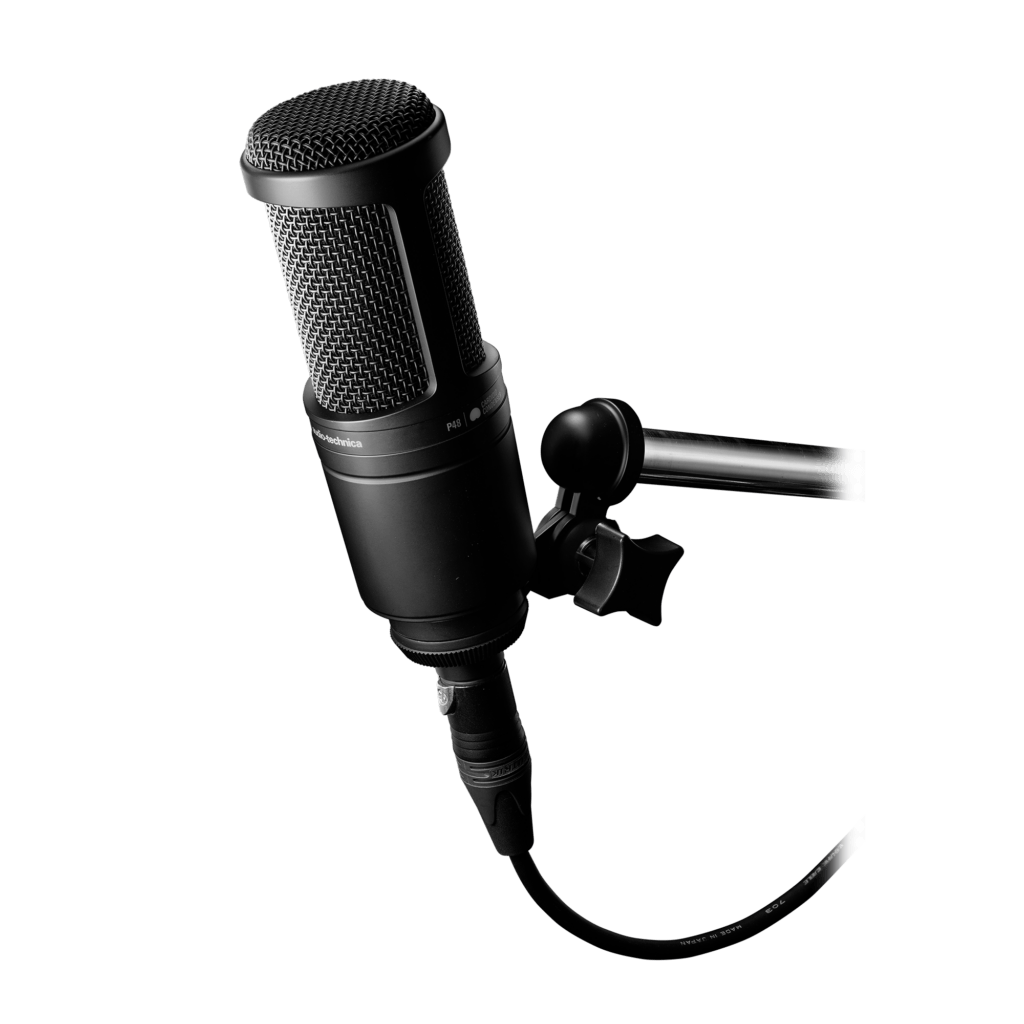
Overview:
The Audio-Technica AT2020 is a staple in the realm of affordable yet dependable condenser microphones for vocal recording. Right out of the box, its build quality is impressive, providing a level of durability not often found at this price point. With a sleek, metallic body and a minimalist design, the AT2020 doesn’t just look professional; it sounds it too.
From my experience, the AT2020 truly shines when tasked with capturing the nuanced details of vocal performances. It has a natural presence boost that brings vocals to the forefront, lending a crispness and clarity that’s hard to match in this tier. This microphone doesn’t just provide great sound for the cost—it competes with some options that are significantly pricier.
An aspect often overlooked in budget microphones is consistency, but the AT2020 delivers a balanced and predictable pickup pattern, ensuring that your recordings are free from unwanted noise and coloration. However, because it’s quite sensitive, it’s crucial to record in a quiet environment or invest in some acoustic treatment to get the best results.
Specs:
- Polar Pattern: Cardioid
- Frequency Response: 20Hz to 20kHz
- Output Connector: XLR
- Phantom Power Requirements: 48V DC, 2mA typical
- Signal to Noise Ratio: 74 dB
Pros:
- Superb build quality relative to its cost.
- Excellent clarity and sound detail, particularly for vocals.
- Minimal self-noise which is great for quiet recording environments.
- Maintains a natural sound without an excessive coloration.
Cons:
- Requires a quiet recording space and may pick up room noises due to its sensitivity.
- Lacks built-in features like a pad or a high-pass filter, which could enhance its versatility.
Price:
The AT2020 sits comfortably in the under-$100 bracket, which is a terrific deal for a microphone that offers professional capabilities. Still, prices may vary slightly depending on the retailer and any bundled accessories, such as mounts or cases.
In sharing my opinion, I have to emphasize that the AT2020 isn’t just about being affordable—it’s about making professional-grade recording accessible. This microphone finds the sweet spot between price and performance, making it an excellent choice for emerging artists, podcasters, and home studio enthusiasts. When your vocals need to sound clear, detailed, and alive, but your budget demands restraint, the AT2020 is a microphone that should be at the top of your list.
AKG P120
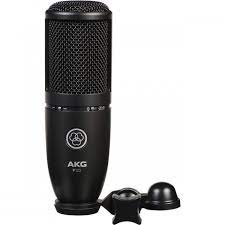
Brief Intro:
The AKG P120 is an entry-level condenser microphone that boasts a solid build and performance capabilities that rival higher-priced alternatives. It’s designed for those who need quality vocal recordings without breaking the bank. Ideal for podcasters, budding musicians, and home studio enthusiasts, the P120 offers a taste of professional audio gear’s sound quality while remaining accessible to those on a budget.
Overview:
When you first get your hands on the AKG P120, you’re likely to be impressed by its sturdy construction. It feels weighty and substantial, which gives a good sense of durability. In testing it with various vocal styles, I found it to capture the nuances of each performance quite well. The sound is crisp and detailed, which is essential for capturing the subtleties of vocal recordings.
One thing to note is how it handles sibilance — those hissing “s” sounds can sometimes overwhelm lesser mics. The P120 manages to keep them in check without the need for additional processing. It also has a low cut filter, which helps eliminate unwanted low-end rumbles like air conditioners or traffic sounds; this feature is a lifesaver for home recording setups that may not have the best sound isolation.
In terms of applications, it’s quite versatile. While it shines for vocals thanks to its inherent clarity, it also does well with acoustic instruments, making it a great all-rounder for your recording needs.
Specs:
- Microphone Type: Condenser
- Polar Pattern: Cardioid
- Frequency Response: 20Hz to 20kHz
- Sensitivity: 24 mV/Pa
- Max SPL: 130 dB
- Low Cut Filter: 300 Hz, 6 dB/octave
- Attenuation Pad: -20 dB
Pros:
- Excellent build quality and feels robust.
- Clear and detailed sound capture that delivers professional-grade recordings.
- Onboard low cut filter and attenuation pad extend its versatility.
- Very little self-noise, which keeps recordings clean.
- Provides great value for its cost.
Cons:
- Requires phantom power, which might necessitate additional gear if your setup doesn’t already support it.
- It’s sensitive to handling noise, so a shock mount is recommended.
- The fixed cardioid pattern means it’s less adaptable to different recording scenarios than multi-pattern microphones.
Price:
The AKG P120 typically retails around $99 USD. For the features and performance it offers, it’s priced competitively, making it one of the best value for money microphones in its category.
In my opinion, the AKG P120 is a no-brainer for anyone who wants to step up their vocal recording game without spending hundreds of dollars. Its performance rivals that of pricier mics, and its design ticks all the boxes for durability and quality. If you’re starting out or looking to expand your microphone locker on a budget, the P120 deserves serious consideration.
MXL 990 Condenser Microphone
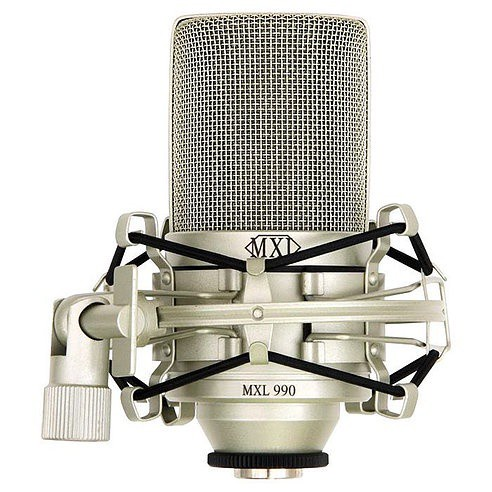
Brief Intro:
The MXL 990 remains one of the industry’s most ground-breaking microphones. The first high-quality condenser microphone that was made accessible to working musicians, the MXL 990 has a FET preamp and a large diaphragm for truly professional sound quality in both digital and analog recordings. This revolutionary condenser microphone continues to astound artists with its silky, high end and tight, solid low and midrange reproduction.
Overview:
The MXL 990 stands out as a versatile and remarkable budget-friendly condenser microphone, tailor-made for those looking to step up their vocal recording quality without breaking the bank. With its classic design and champagne finish, it holds an aesthetic appeal that belies its affordability. In testing the MXL 990, I immediately noticed its warmth in vocal reproduction, which lends itself well both to spoken word and sung vocals. It captures the subtle nuances of a performance with a surprising level of detail for its price range.
In a home studio environment, the MXL 990 shines with its balanced sound, although it tends to favor the midrange. This characteristic warmth is a huge plus for vocalists seeking a microphone that doesn’t sound overly harsh or clinical. It doesn’t have the bells and whistles of more expensive mics, but it’s a reliable workhorse for those who are after straightforward high-quality recording.
Specs:
- Type: Pressure gradient condenser microphone
- Capsule Size: 6 micron, 20mm
- Frequency Response: 30Hz – 20kHz
- Polar Pattern: Cardioid
- Sensitivity: 15mV/Pa
- Impedance: 200 ohms
- S/N Ratio: 80dB (Ref. 1Pa A-weighted)
- Equivalent Noise Level: 20dB (A-weighted IEC 268-4)
- Max SPL for 0.5% THD: 130dB
- Power Requirements: 48V phantom power (+/- 4V)
Pros:
- Exceptional value for the price
- Warm sound profile that’s flattering for vocals
- Simple and easy to use for beginners and professionals alike
- Stylish design with a vintage vibe
Cons:
- Lacks additional features like pads or filters
- Can be sensitive to plosives and sibilants without a pop filter
- Requires a separate power source (48V phantom power)
Price:
The MXL 990 can often be found hovering around the $80-$100 mark. It’s a testament to the company’s dedication to making recording more accessible without compromising too much on quality. The price-point makes it an entry-level microphone that truly exceeds expectations in its category.
Behringer C-1 Condenser Microphone
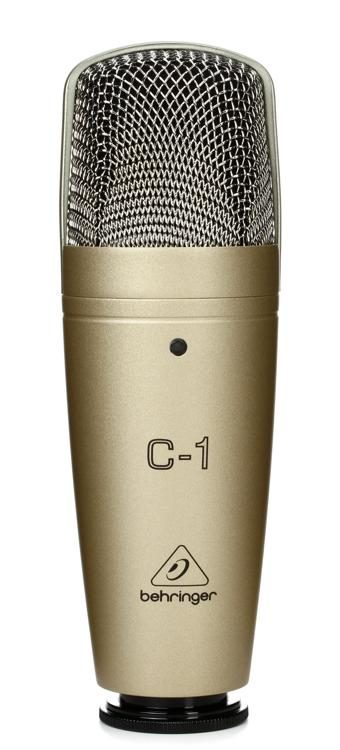
Overview:
The Behringer C-1 is a budget-friendly condenser microphone that surprisingly doesn’t cut corners on quality as much as one might expect for the price point. Aimed at home studio enthusiasts and those just starting their journey into audio recording, the C-1 serves as a solid groundwork for recording vocals and acoustic instruments with reasonable clarity and accuracy.
From my experience with the Behringer C-1, I’ve found it to capture a more neutral sound compared to some of the slightly more colored alternatives out there. It doesn’t quite flatter the vocals in the way pricier microphones might, but it doesn’t egregiously color them either, making it a solid, dependable choice for those looking for an uncolored representation of their voice or instrument.
Specs:
- Pickup Pattern: Cardioid
- Frequency Response: 40 Hz to 20 kHz
- Impedance: 100 Ohms
- Sensitivity: -45 dBV (0 dBV = 1 V/Pa), 1 kHz
Pros:
- The price-to-performance ratio is where the C-1 shines. For a fraction of the cost of high-end studio microphones, you get a performance that exceeds expectations.
- It’s quite durable. The build quality feels sturdy, meaning it can handle the occasional mishap in a home studio environment.
- The C-1 has a low noise floor, which is essential for clean recordings. When paired with a good preamp, it can yield recordings with minimal hiss or background noise.
Cons:
- The microphone lacks some of the warmth and subtlety you’d find in more expensive condenser mics. This isn’t a huge deal for beginners but could be noticed by those with a more trained ear.
- It does require phantom power, which isn’t a con per se, but it means you need an audio interface or mixer that can provide it, potentially adding to the overall cost if you don’t already have this equipment.
- Included accessories are minimal – you get a stand adapter and a hard case, but no shock mount or pop filter, which are recommended for recording vocals.
Price:
Typically, the Behringer C-1 falls somewhere in the $40 to $60 range, making it one of the most affordable condenser mics on the market that still maintains a level of quality suitable for more than just hobbyist recording. This price point is its biggest selling feature for novice engineers and podcasters on a budget.
In conclusion, the Behringer C-1 is a commendable microphone for beginners or those needing an inexpensive solution to capture vocals without the bells and whistles of higher-end mics. Its neutral sound capture and sturdy construction make it a worthy consideration for entry-level recording setups. If your priority is to save money while still getting a microphone that can give you a decent start in vocal recording, the Behringer C-1 should definitely be on your list.
Samson C01
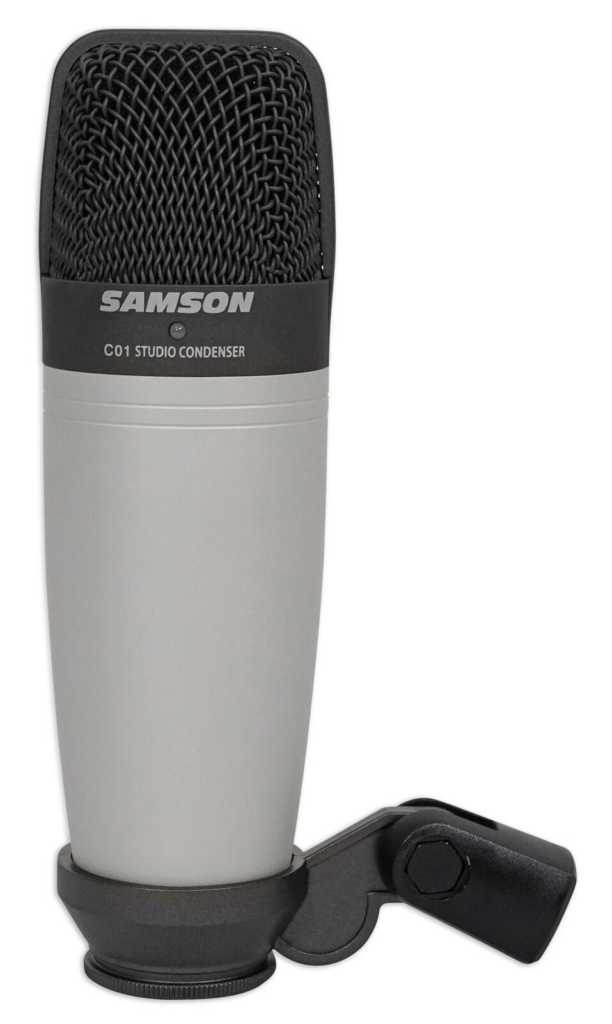
Overview
The Samson C01 has earned a reputation as a reliable entry-level microphone that doesn’t cut corners on quality, despite its affordability. Upon handling the C01, the build quality immediately stands out—it feels sturdy and like it could survive the inevitable bump or knock. Aesthetically, it’s quite sleek with a professional-looking design that belies its price point.
This microphone particularly shines when capturing vocals. It boasts a large diaphragm, which is unusual in its price range, and this translates into the C01’s ability to pick up the subtle nuances and warmth of the human voice. Its cardioid pickup pattern focuses on the sound source directly in front of the microphone, which helps minimize unwanted background noise—a boon for home studio enthusiasts who may not be working in perfectly silent environments.
In my experience, the C01 performs incredibly well for both spoken word and sung vocals. There’s a certain clarity and presence in the recordings that is impressive, considering the mic’s cost. However, while it does its job well for a budget condenser, don’t expect it to match the performance of high-end mics used in professional studios. Nevertheless, for someone just starting out or looking for a budget-friendly home setup, the C01 presents a fantastic value.
Specs
- Type: Large-diaphragm condenser
- Polar Pattern: Cardioid
- Frequency Response: 40Hz-18kHz
- Sensitivity: -33 dBV/pa (22.4mV/pa)
- SPL Handling: 136 dB
Pros:
- The large diaphragm captures vocals with warmth and clarity.
- Robust build quality gives confidence in the mic’s longevity.
- It offers a professional look and feel that exceeds expectations for the price.
- Focused cardioid pattern helps isolate the main sound source.
Cons:
- Lacks some of the finer detail and richness found in higher-end microphones.
- May require additional pop filter and shock mount for best results.
- Its simplicity might limit versatility compared to more feature-rich competitors.
Price
The Samson C01 typically falls within the $70 to $80 price range. Given its solid performance as a vocal microphone, this price represents excellent value for those on a tight budget or who are beginning to build their home recording setup.
Hollyland Lark M1
Overview:
Although the Hollyland Lark M1 is not a condenser microphone, it is still included on this list to ensure you don’t miss a masterpiece of technology. Lark M1 is a wireless mic kit with an excellent range of around 650ft. It is available in 1x TX/RX and 2x TX/RX variations. Home to cutting-edge technology combined with an extremely user-friendly design, this microphone delivers high audio quality equivalent to a condenser microphone.
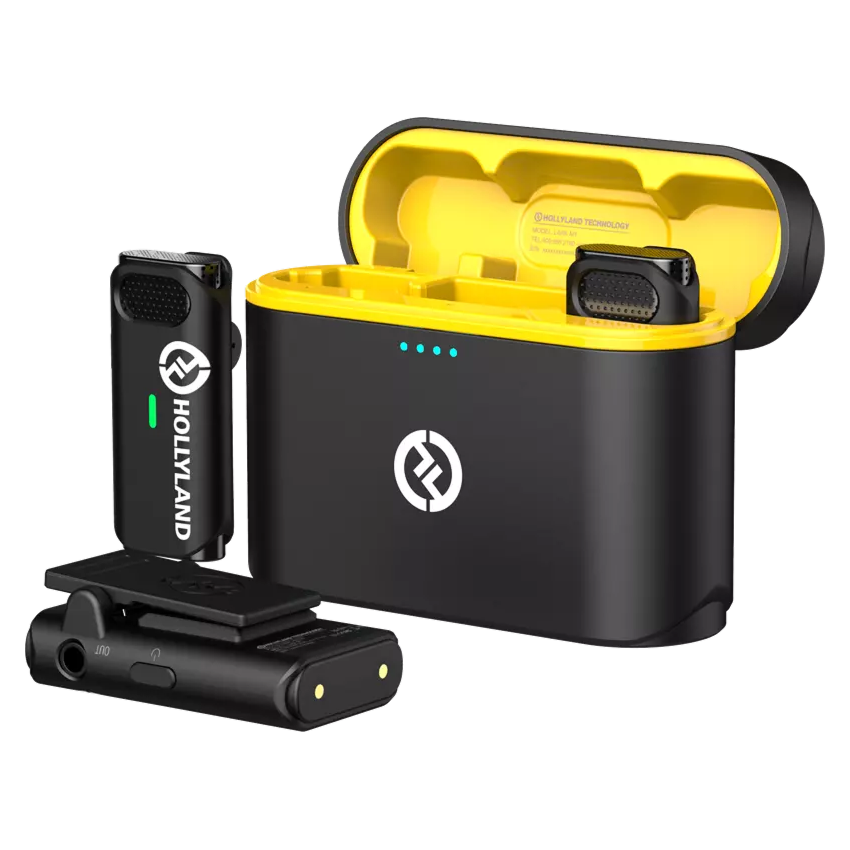

Hollyland LARK M1 - Tiny Wireless Microphone
A lightweight and user-friendly wireless microphone with one-click noise cancellation.
Key Features: Hi-Fi Sound Quality | Tiny & Light Design | Plug and Play
As a lavalier-style device, this microphone proves its mettle to become a top choice for those looking for outstanding audio quality without worrying about wires. The product is manufactured to fulfill the needs of content creators, vloggers, and streamers who always strive for audio quality in their videography journey.
One of the best features of the Hollyland Lark M1 is its advanced-grade Digital Signal Processing (DSP). When this DSP system combines with the smart noise-canceling algorithm, it creates strong barriers to prevent unwanted sounds from interfering with the captured audio. And when these two superb technologies meet the HearClear feature, it makes Lark M1 capture and reproduce crystal-clear sounds no matter if you’re using the mic indoors or outdoors.
But it doesn’t mean you cannot control the immersive audio level with this wireless microphone. The Lark M1 comes with a toggle that can turn on and off the HearClear feature, allowing you to savor an improved immersive audio experience with more precise ambient sounds. At the same time, this microphone permits you to choose from three different volumes (High – Mid – Low) to capture the audio according to specific recording environments and scenarios.
Specs:
- Polar Pattern: Omnidirectional
- Frequency Response: 20Hz to 20kHz
- Output Connector: 3.5mm TRS jack
- Max SPL: 110dB
- Dynamic Range: 86dB
- Battery Life (TX/RX): 8 hours
- Charging Time (all units): 1.5 hours
Pros:
- Cost-effective wireless mic compared to branded condenser mics
- This microphone pairs easily with most DSLRs and action cameras
- Users are satisfied with the wireless range it offers
- Clear audio despite TX’s small size
Cons:
- There is no built-in voice recording option
Price:
If you purchase the 1x transmitter and receiver for solo recording, the Hollyland Lark M1 costs under $60. Conversely, the price range of 2x transmitters and 1x receiver (duo version) is around $110.
After gauging several user reviews, the Hollyland Lark M1 appears to be a durable and user-friendly wireless microphone, which can be an ideal alternative to condenser mics. You can use it for podcasts, interviews, and more without being bound to cables.
Conclusion:
In closing, finding the best cheap condenser microphone for vocals doesn’t mean you have to compromise on quality. The options we’ve explored provide a great balance of affordability and performance, ensuring you can capture clear, detailed vocals without breaking the bank. Whether you’re a budding podcaster, a musician on a budget, or an aspiring voice-over artist, there’s a microphone on this list that will meet your needs and help you produce professional-sounding content.
FAQs:
Q1: Do I need a special interface to use a condenser microphone?
A1: Yes, most condenser microphones require phantom power, which can be provided by an audio interface or a mixer with a built-in preamp.
Q2: Can I use a cheap condenser microphone for professional recordings?
A2: Absolutely. While high-end mics offer certain premium features, many affordable condenser microphones deliver excellent sound quality suitable for professional recordings, especially if you’re starting out or have a home studio.
Q3: Are there any additional accessories I should consider with my condenser microphone?
A3: For optimal audio capture, consider getting a pop filter to reduce plosive sounds, a shock mount to diminish mechanical noises, and an appropriate stand or boom arm for ease of use.


































.png)


